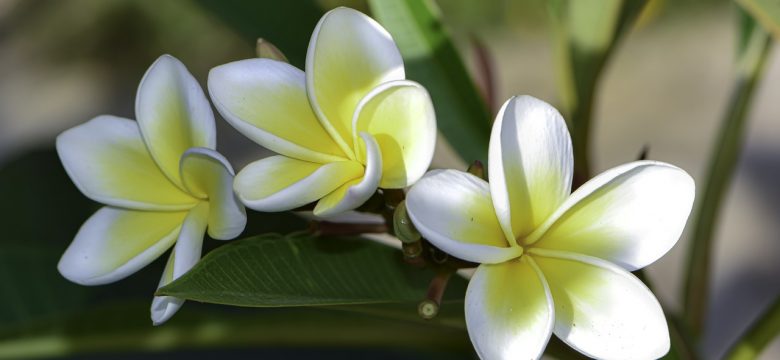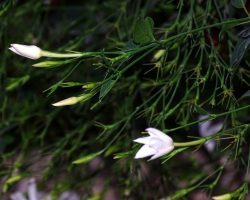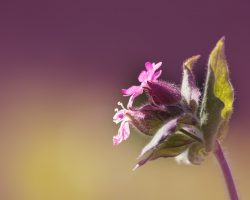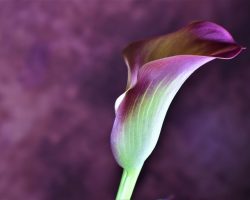The jasmine flower is not only known for its enchanting fragrance but also for its deep meanings and symbolism. Found in many cultures around the world, this beautiful plant holds different significance and represents various emotions and qualities.
In different parts of the world, the jasmine flower is associated with love, purity, and spirituality. It is often seen as a symbol of beauty, grace, and elegance. In some cultures, it is believed to bring good luck and ward off evil spirits. The delicate white petals of the jasmine flower also symbolize innocence and purity.
The jasmine flower has been a subject of fascination in literature and poetry. It is often used as a metaphor for beauty, sensuality, and romance. Its intoxicating fragrance is compared to the sweetest of scents, captivating the senses and evoking feelings of passion and desire.
In addition to its literary symbolism, the jasmine flower also holds mythological connections. In different mythologies across the globe, it is associated with deities and legendary figures. It is believed to have divine qualities and is often used in religious ceremonies and rituals.
Furthermore, the jasmine flower has religious significance in various faiths, including Hinduism, Buddhism, and Islam. It is used in religious offerings, decorations, and as a symbol of spirituality and devotion. Its presence in religious ceremonies signifies purity and the presence of the divine.
Overall, the jasmine flower is not only a visually stunning plant but also a symbol of love, purity, spirituality, and beauty. Its meanings and symbolism have captivated people for centuries, making it a cherished flower in many cultures around the world.
Cultural Significance
The jasmine flower is not just a beautiful and fragrant plant, but it also holds deep cultural significance in many parts of the world. It is revered for its symbolism of love, purity, and spirituality in various traditions and cultures. Let’s explore the cultural significance of the jasmine flower and how it is celebrated in different parts of the globe.
In many Asian cultures, the jasmine flower is considered a symbol of love and affection. It is often used in wedding ceremonies and is given as a gift to express love and devotion. The delicate and sweet fragrance of the jasmine flower is believed to enhance the romantic atmosphere and bring good luck to the newlyweds.
In some Middle Eastern cultures, the jasmine flower represents purity and innocence. It is commonly used in religious ceremonies and is considered sacred. The fragrance of the jasmine flower is believed to purify the soul and bring inner peace and tranquility.
The jasmine flower also has spiritual significance in Hinduism. It is associated with the Hindu goddess Saraswati, who is the goddess of knowledge, music, and art. The jasmine flower is offered to the goddess as a symbol of purity and devotion.
In addition to its symbolic meanings, the jasmine flower is also used in various cultural practices. In India, for example, the jasmine flower is used to make garlands and is worn in the hair as a symbol of beauty and grace. In China, the jasmine flower is often brewed into tea and is believed to have calming and soothing effects.
Overall, the jasmine flower holds a special place in different cultures around the world, representing love, purity, and spirituality. Its beauty and fragrance have captivated people for centuries, making it a cherished symbol in various traditions.
Historical Background
The jasmine flower has a rich historical background that dates back centuries. Its origins can be traced to ancient civilizations, where it played a significant role in various rituals and ceremonies. In many cultures, the jasmine flower symbolized purity, love, and spirituality.
One of the earliest recorded uses of jasmine can be found in ancient Egypt, where it was highly regarded for its fragrance and beauty. It was often used in religious ceremonies and as an adornment for the hair and body. The Egyptians believed that the scent of jasmine had the power to attract the attention of the gods.
In ancient Greece, jasmine was associated with the goddess Aphrodite, the goddess of love and beauty. It was believed that the flower had the ability to enhance one’s attractiveness and bring about feelings of passion and romance. The Greeks also used jasmine in perfumes and as a decorative element in weddings and festivals.
In India, jasmine holds a special place in Hindu mythology and is often associated with the god Vishnu and the goddess Lakshmi. It is considered a sacred flower and is used in religious ceremonies, particularly during weddings and festivals. In addition to its religious significance, jasmine is also highly valued for its fragrance and is widely used in the production of perfumes and incense.
The historical background of the jasmine flower is vast and varied, with different civilizations and cultures attributing different meanings and uses to this beautiful flower. From ancient Egypt to Greece to India, the jasmine flower has left its mark on history and continues to be cherished for its beauty, fragrance, and symbolism.
Symbolism in Literature
The jasmine flower has long been a source of inspiration for writers and poets, who have used its delicate beauty and intoxicating fragrance to convey deeper meanings in their works. In literature, the jasmine flower often serves as a metaphor for beauty and sensuality, representing the allure and allure of the natural world. Its elegant and graceful appearance has been compared to the beauty of a woman, with its intoxicating fragrance symbolizing the irresistible charm and allure of love.
Furthermore, the jasmine flower holds symbolic significance in poetry and prose, representing various themes and emotions. It is often associated with purity and innocence, with its pristine white petals symbolizing purity of heart and soul. In some works, the jasmine flower is used to convey themes of longing and desire, evoking a sense of yearning and passion. Its fragrance is seen as a symbol of the ephemeral nature of beauty and the transient nature of life itself.
Mythological Connections
Delve into the mythological connections of the jasmine flower, and explore its associations with deities and legendary figures in various mythologies around the world. The jasmine flower has been revered and celebrated in different cultures for centuries, and its mythological significance adds to its allure and mystique.
In Greek mythology, the jasmine flower is associated with the goddess Aphrodite, the goddess of love and beauty. According to one myth, when Aphrodite was born from the sea foam, jasmine flowers bloomed in her wake, symbolizing her divine beauty and sensuality. In Hindu mythology, the jasmine flower is linked to the god Vishnu, who is often depicted adorned with jasmine garlands. The fragrance of jasmine is believed to be pleasing to the gods and is used in religious ceremonies and offerings.
In Chinese mythology, the jasmine flower is associated with purity and grace. It is often depicted in paintings and poetry as a symbol of elegance and refinement. In Arabian folklore, the jasmine flower is said to have magical properties and is associated with love and romance. It is believed that the scent of jasmine can attract love and bring good luck.
Across different mythologies, the jasmine flower holds symbolic significance and is often associated with beauty, purity, love, and spirituality. Its delicate and fragrant blooms have captured the imagination of people throughout history, inspiring tales of love, devotion, and enchantment.
Religious Symbolism
Religious Symbolism
The jasmine flower holds great religious significance in various faiths, including Hinduism, Buddhism, and Islam. In Hinduism, jasmine is considered sacred and is often used in religious ceremonies and rituals. It is associated with the goddess Saraswati, the deity of knowledge, music, and arts. The fragrance of jasmine is believed to enhance concentration and bring about a sense of tranquility, making it a popular choice for offering to the gods.
In Buddhism, jasmine is also highly revered and is often used as a symbol of purity and enlightenment. The flower is associated with the concept of mindfulness and is used as an offering to the Buddha. Its delicate and fragrant blooms represent the beauty and impermanence of life, reminding practitioners to appreciate the present moment.
In Islam, jasmine is considered a symbol of purity and is often associated with paradise. It is mentioned in the Quran and is believed to be one of the fragrant flowers found in Jannah (heaven). Jasmine is used in religious ceremonies, particularly during weddings, to signify purity, beauty, and the blessings of Allah.
Botanical Features
The jasmine flower, known for its delicate beauty and intoxicating fragrance, possesses a variety of botanical features that make it a unique and sought-after plant. In terms of appearance, jasmine flowers are typically small and white, although some species may also produce yellow or pink blooms. These flowers are often star-shaped, with five or more petals that radiate outwards, creating a stunning display.
When it comes to growth patterns, jasmine plants are known for their vigorous climbing or trailing nature. They have long, slender stems that can reach impressive lengths, allowing them to twine around trellises, fences, or other support structures. This makes jasmine an excellent choice for adding vertical interest to gardens or creating natural privacy screens.
There are several species and varieties of jasmine available, each with its own unique characteristics and fragrance. Some popular types include Jasminum officinale, which is known for its sweet scent and is commonly used in perfumery, and Jasminum sambac, also known as Arabian jasmine, which is highly prized for its rich floral aroma. Other notable species include Jasminum grandiflorum, Jasminum polyanthum, and Jasminum auriculatum.
Uses and Applications
The jasmine flower is known for its diverse uses and applications, making it a highly versatile plant. Its enchanting fragrance and therapeutic properties have made it a popular choice in various industries. Let’s explore the different ways in which this beautiful flower is utilized:
- Perfumery and Aromatherapy: Jasmine is widely used in the perfume industry due to its intoxicating scent. It is often included in high-end perfumes and fragrances, adding a touch of elegance and sensuality. In aromatherapy, jasmine essential oil is cherished for its calming and uplifting effects, promoting relaxation, reducing stress, and enhancing mood.
- Culinary Delights: The jasmine flower is not only pleasing to the senses but also adds a unique floral flavor to various culinary creations. It is commonly used in teas, infusions, and desserts, infusing them with a delicate and aromatic essence. In some cuisines, jasmine flowers are even incorporated into traditional dishes, elevating the overall taste and visual appeal.
- Medicinal Properties: Jasmine has long been recognized for its medicinal properties in traditional medicine. It is believed to have anti-inflammatory, antiseptic, and analgesic properties. Jasmine tea is often consumed for its potential health benefits, including improving digestion, boosting immunity, and reducing anxiety.
From perfumery to culinary delights and medicinal applications, the jasmine flower continues to captivate and contribute to various industries. Its versatility and enchanting qualities make it a cherished and valuable plant.
Perfumery and Aromatherapy
The importance of jasmine in the perfume industry cannot be overstated. Its delicate and intoxicating fragrance has made it a prized ingredient in perfumes for centuries. The scent of jasmine is often associated with romance and sensuality, and it adds a touch of elegance and sophistication to any fragrance.
But jasmine’s benefits go beyond its use in perfumery. It also has therapeutic properties that make it a popular choice in aromatherapy. The aroma of jasmine has been found to promote relaxation, reduce stress, and enhance mood. Inhaling the scent of jasmine oil can help calm the mind and uplift the spirit, making it a valuable tool for managing anxiety and promoting emotional well-being.
- Jasmine oil can be used in diffusers or added to bathwater to create a soothing and calming atmosphere.
- It can also be used in massage oils or lotions to promote relaxation and relieve muscle tension.
- Some people find that inhaling the scent of jasmine oil before bedtime can help improve the quality of sleep and promote a sense of tranquility.
Whether used in perfumery or aromatherapy, jasmine offers a range of benefits that can enhance both physical and emotional well-being. Its exquisite fragrance and therapeutic properties make it a valuable addition to any fragrance collection or self-care routine.
Culinary Delights
Culinary enthusiasts are in for a treat as they explore the delightful world of jasmine flower in the kitchen. This fragrant blossom offers a unique floral flavor that adds a touch of elegance to teas, desserts, and traditional dishes in various cuisines.
One of the most popular uses of jasmine flower in culinary creations is in teas. The delicate and soothing aroma of jasmine infuses beautifully with tea leaves, creating a refreshing and aromatic beverage. Jasmine tea is particularly beloved in Chinese culture, where it is often served as a symbol of hospitality and friendship.
In addition to teas, jasmine flower is also a favorite ingredient in desserts. From delicate jasmine-infused cakes and pastries to creamy jasmine-flavored ice creams, the floral notes of this blossom lend a subtle and enchanting taste to sweet treats. It’s no wonder that jasmine desserts are often considered a luxurious indulgence.
Furthermore, jasmine flower finds its place in traditional dishes in various cuisines. In Indian cuisine, for example, jasmine rice is a staple that pairs perfectly with aromatic curries and flavorful stews. The fragrance of jasmine elevates the dining experience, adding an extra layer of sensory delight to every bite.
Whether it’s in a cup of tea, a decadent dessert, or a savory dish, the culinary delights of the jasmine flower are sure to captivate the taste buds and leave a lasting impression. Its unique floral flavor brings a touch of elegance and sophistication to any culinary creation, making it a cherished ingredient in kitchens around the world.
Gardening and Cultivation
Gardening and Cultivation
If you’re looking to grow and cultivate jasmine plants in your own garden, there are a few important tips to keep in mind. Jasmine plants thrive in warm climates and prefer well-drained soil with plenty of sunlight. It’s best to plant them in a location that receives at least six hours of direct sunlight each day.
When it comes to watering, jasmine plants require regular watering to keep the soil consistently moist. However, be careful not to overwater them as this can lead to root rot. It’s a good idea to water the plants deeply once or twice a week, allowing the soil to dry out slightly between waterings.
Pruning is an essential part of jasmine plant care. Regular pruning helps maintain the plant’s shape and encourages healthy growth. It’s best to prune jasmine plants in early spring before new growth begins. Remove any dead or damaged branches, as well as any branches that are crossing or crowding each other.
While jasmine plants are generally low-maintenance, there are a few common challenges to watch out for. Pests such as aphids, spider mites, and whiteflies can sometimes infest jasmine plants. Regularly inspect your plants for any signs of pest infestation and take appropriate measures to control them.
In addition, jasmine plants are susceptible to fungal diseases such as powdery mildew and root rot. To prevent these diseases, ensure proper air circulation around the plants and avoid overwatering. If necessary, apply fungicides to protect the plants.
By following these tips, you can successfully grow and cultivate jasmine plants in your own garden, enjoying their beautiful flowers and delightful fragrance.
Popular Jasmine Varieties
When it comes to garden cultivation, there are several popular jasmine varieties that can add beauty and aroma to your outdoor space. Each variety has its own unique characteristics and fragrance, making them a delightful addition to any garden.
| Variety | Characteristics | Fragrance |
|---|---|---|
| Common Jasmine (Jasminum officinale) | This is one of the most widely cultivated jasmine varieties, known for its elegant white flowers and glossy green leaves. It is a vigorous climber and can reach up to 20 feet in height. | The fragrance of common jasmine is sweet and intoxicating, filling the air with its rich floral scent. |
| Star Jasmine (Trachelospermum jasminoides) | This variety is prized for its beautiful star-shaped white flowers and glossy dark green leaves. It is a versatile plant that can be grown as a climber or a ground cover. | The fragrance of star jasmine is sweet and exotic, reminiscent of tropical flowers. |
| Arabian Jasmine (Jasminum sambac) | Arabian jasmine is a compact shrub with small, waxy, and highly fragrant white flowers. It is a popular choice for container gardening and can also be trained as a climber. | The fragrance of Arabian jasmine is intensely sweet and floral, often described as heavenly. |
These are just a few examples of the popular jasmine varieties available for garden cultivation. Whether you choose the classic beauty of common jasmine, the starry allure of star jasmine, or the heavenly scent of Arabian jasmine, adding these varieties to your garden will surely create a sensory delight for you and your visitors.
Care and Maintenance
Proper care and maintenance are crucial for ensuring the healthy growth of jasmine plants. By following a few essential practices, you can enjoy the beauty and fragrance of these delicate flowers for years to come.
Watering: Jasmine plants require regular watering, especially during the growing season. It is important to keep the soil consistently moist but not waterlogged. A good rule of thumb is to water deeply once or twice a week, allowing the top inch of soil to dry out between waterings.
Fertilizing: To promote healthy growth and abundant blooms, it is recommended to fertilize jasmine plants regularly. Use a balanced fertilizer specifically formulated for flowering plants and follow the instructions on the package. Apply the fertilizer every four to six weeks during the growing season.
Protecting from Pests and Diseases: Jasmine plants can be susceptible to pests such as aphids, mealybugs, and spider mites. Regularly inspect the plants for any signs of infestation and take appropriate measures to control the pests. Additionally, keep an eye out for common diseases like powdery mildew and leaf spot, and treat them promptly with suitable fungicides.
By providing adequate water, nutrients, and protection from pests and diseases, you can ensure the healthy growth of your jasmine plants and enjoy their beautiful blooms and delightful fragrance.
Frequently Asked Questions
- What are the different cultural significances of the jasmine flower?
The jasmine flower holds deep cultural significance in various parts of the world. In some cultures, it represents love and romance, symbolizing beauty and purity. In other traditions, it is associated with spirituality and is used in religious ceremonies and rituals.
- What is the historical background of the jasmine flower?
The jasmine flower has a rich historical background. It originated in ancient Persia and was cultivated in Egypt and India. It was highly valued in ancient civilizations for its fragrance and was used in perfumes, oils, and as adornments in ceremonies and celebrations.
- How is the jasmine flower represented in literature?
The jasmine flower has been used as a metaphor for beauty, sensuality, and purity in literature. It is often associated with romance and love, appearing in poems and prose as a symbol of delicate and captivating beauty.
- Are there any mythological connections to the jasmine flower?
Yes, the jasmine flower has mythological connections in various cultures. In Greek mythology, it is associated with the goddess Aphrodite, the goddess of love and beauty. In Hindu mythology, it is linked to the god Vishnu and is considered sacred.
- What is the religious symbolism of the jasmine flower?
The jasmine flower holds religious significance in different faiths. In Hinduism, it is offered to deities during worship and is associated with purity and divinity. In Buddhism, it represents purity of thought and is used in meditation practices. In Islam, it is seen as a symbol of beauty and is used in perfumes and religious ceremonies.
- What are the botanical features of the jasmine flower?
The jasmine flower is known for its fragrant and delicate white or yellow blossoms. It belongs to the Oleaceae family and is characterized by its climbing vines or shrubs. There are various species and varieties of jasmine, each with its own unique appearance and fragrance.
- What are the uses and applications of the jasmine flower?
The jasmine flower has diverse uses and applications. It is widely used in the perfume industry for its sweet and intoxicating scent. It is also used in aromatherapy for its calming and mood-enhancing properties. In culinary arts, jasmine is used in teas, desserts, and traditional dishes to add a floral flavor.
- How can I grow and cultivate jasmine plants in my garden?
To grow jasmine plants, provide them with well-drained soil and ample sunlight. Regular watering and pruning are essential for healthy growth. Protect the plants from extreme temperatures and pests. Choose from popular jasmine varieties like Jasminum sambac or Jasminum officinale, each offering its own unique fragrance and beauty.
- What are the care and maintenance practices for jasmine plants?
Jasmine plants require regular watering, especially during dry spells. Fertilize them with a balanced fertilizer to promote healthy growth. Pruning is necessary to maintain their shape and control their size. Keep an eye out for pests and diseases, and take appropriate measures to protect your jasmine plants.





